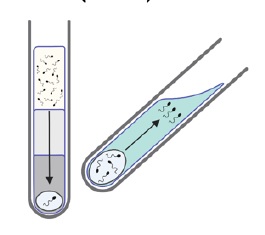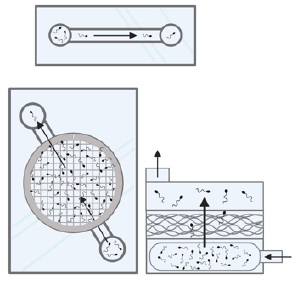Knowledge Sharing
2023.08.03
The novel microfluidic device can assist infertility patients in separating motile sperm
Author: Embryologist Jung-Hsiu Su and Researcher Jian-Hong Chen, Ph.D. from Lee Women’s Hospital
Currently, the standard clinical procedure is to use the density gradient centrifugation method (Figure 1) to process semen samples, separating motile and mature sperm with higher density than static or immature sperm. In recent years, a microfluidic device (Figure 2) has been developed, which can effectively separate motile and morphologically normal sperm without the need for centrifugation. This potentially avoids the generation of oxidative pressure or DHA caused by centrifugation. The principle of the microfluidic device is to simulate the natural barriers that sperm must pass through in the cervix and uterus before fertilization, utilizing sperm motility for separation.
It is already known that using a microfluidic device to process semen samples can effectively collect motile sperm and reduce sperm DNA fragmentation. Therefore, in 2022, Molly M. Quinn and Liza Jalalian, along with other authors, published another study in Human Reproduction. This study used a randomized grouping, with one group using density gradient centrifugation as the control and the other group using the microfluidic device (ZyMotVR ICSI Sperm Separation Device) for semen processing. The study compared the fertilization rate, embryo quality on the third and fifth day, and post-implantation outcomes between the two groups. The results of this study showed no significant differences in fertilization rate (control group 79.4% vs. experimental group 75.2%), high-quality embryo rate on the third day (66% vs. 68%), high-quality blastocyst rate (37.4% vs. 37.4%), clinical pregnancy rate after implantation (57.4% vs. 51.6%), and ongoing pregnancy rate (44.1% vs. 44%).
Although this study found no significant differences in embryo development and clinical outcomes between the microfluidic device and density gradient centrifugation methods in ICSI fertilization, this approach did not affect or compromise embryo development and clinical outcomes. The authors of this study suggest that in future research, comparing density gradient centrifugation with the microfluidic device in ICSI fertilization for cases known to have male factor infertility, elevated sperm DNA fragmentation, or previous IVF results that did not meet expectations, may further explore the benefits of the microfluidic device in IVF.
Based on the advantages of microfluidic sperm separation, Lee Women's Hospital collaborated with partners in 2022 to develop a microfluidic sperm selector. The product has shown promising initial results, as it allows for the simple and rapid separation of motile and high-quality sperm. Test results demonstrated that the prepared sperm had a lower proportion of DNA fragmentation. This research product has been used in infertility treatment, benefiting male infertility patients.
Male factors are one of the main causes of infertility
Male factors account for 20-30% of all infertility cases, including sperm abnormalities, anatomical abnormalities in the reproductive system, endocrine, dysfunction, or immunological abnormalities, and more. Although semen analysis can be used for the diagnosis of male infertility, it is still possible for other male factors to lead to a decline in fertility even if the semen analysis result is normal. Within a single ejaculate, there is a significant variation in sperm morphology. Therefore, the separation of good sperm is crucial for infertility treatment.Currently, the standard clinical procedure is to use the density gradient centrifugation method (Figure 1) to process semen samples, separating motile and mature sperm with higher density than static or immature sperm. In recent years, a microfluidic device (Figure 2) has been developed, which can effectively separate motile and morphologically normal sperm without the need for centrifugation. This potentially avoids the generation of oxidative pressure or DHA caused by centrifugation. The principle of the microfluidic device is to simulate the natural barriers that sperm must pass through in the cervix and uterus before fertilization, utilizing sperm motility for separation.

▲Figure 1: Density gradient centrifugation method
|

▲Figure 2: Microfluidic device
|
The microfluidic device can collect motile sperm with low DNA fragmentation
In 2018, Molly M. Quinn and Liza Jalalian, along with other authors, published a study in the journal Human Reproduction. The study mainly compared the results of semen analysis after processing semen samples using density gradient centrifugation and a microfluidic device. The results showed that both methods significantly increased the percentage of sperm with progressive motility compared to the original samples, with the microfluidic device showing better results statistically. However, the microfluidic device collected fewer sperm compared to density gradient centrifugation. Additionally, the analysis of sperm DNA fragmentation showed a significant reduction in DNA fragmentation with density gradient centrifugation, while almost no detectable DNA fragmentation was observed with the microfluidic device.It is already known that using a microfluidic device to process semen samples can effectively collect motile sperm and reduce sperm DNA fragmentation. Therefore, in 2022, Molly M. Quinn and Liza Jalalian, along with other authors, published another study in Human Reproduction. This study used a randomized grouping, with one group using density gradient centrifugation as the control and the other group using the microfluidic device (ZyMotVR ICSI Sperm Separation Device) for semen processing. The study compared the fertilization rate, embryo quality on the third and fifth day, and post-implantation outcomes between the two groups. The results of this study showed no significant differences in fertilization rate (control group 79.4% vs. experimental group 75.2%), high-quality embryo rate on the third day (66% vs. 68%), high-quality blastocyst rate (37.4% vs. 37.4%), clinical pregnancy rate after implantation (57.4% vs. 51.6%), and ongoing pregnancy rate (44.1% vs. 44%).
Although this study found no significant differences in embryo development and clinical outcomes between the microfluidic device and density gradient centrifugation methods in ICSI fertilization, this approach did not affect or compromise embryo development and clinical outcomes. The authors of this study suggest that in future research, comparing density gradient centrifugation with the microfluidic device in ICSI fertilization for cases known to have male factor infertility, elevated sperm DNA fragmentation, or previous IVF results that did not meet expectations, may further explore the benefits of the microfluidic device in IVF.
Based on the advantages of microfluidic sperm separation, Lee Women's Hospital collaborated with partners in 2022 to develop a microfluidic sperm selector. The product has shown promising initial results, as it allows for the simple and rapid separation of motile and high-quality sperm. Test results demonstrated that the prepared sperm had a lower proportion of DNA fragmentation. This research product has been used in infertility treatment, benefiting male infertility patients.
Referance:
- Quinn, M. M., Ribeiro, S., Hernandez, F. J., Simbulan, R. K., Jalalian, L., Cedars, M. I., & Rosen, M. P. (2022). Microfluidic Preparation of Spermatozoa for ICSI Produces Similar Embryo Quality to Density-Gradient Centrifugation: A Pragmatic, Randomized Controlled Trial. Human Reproduction, 37(7), 1406–1413. https://doi.org/doi.org/10.1093/humrep/deac099
- Quinn, M. M., Jalalian, L., Ribeiro, S., Ona, K., Demirci, U., Cedars, M. I., & Rosen, M. P. (2018). Microfluidic Sorting Selects Sperm for Clinical Use with Reduced DNA Damage Compared to Density Gradient Centrifugation with Swim-up in Split Semen Samples. Human Reproduction, 33(8), 1388–1393.https://doi.org/10.1093/humrep/dey239
- Orsolini , M. F., Meyers , S. A., & Dini , P. (2021). SettingsOrder Article Reprints Open AccessReview An Update on Semen Physiology, Technologies, and Selection Techniques for the Advancement of In Vitro Equine Embryo Production: Section II. Animals, 11(11), 3319. https://doi.org/10.3390/ani11113319




